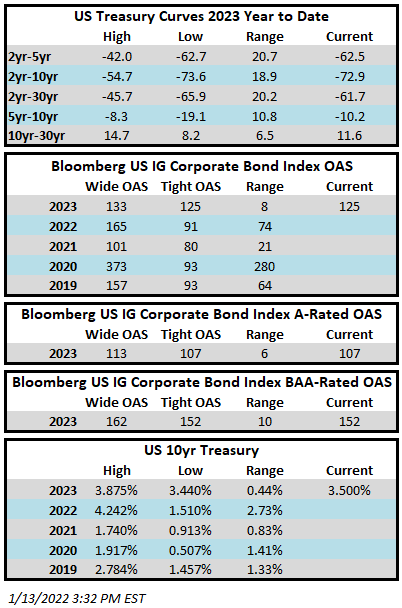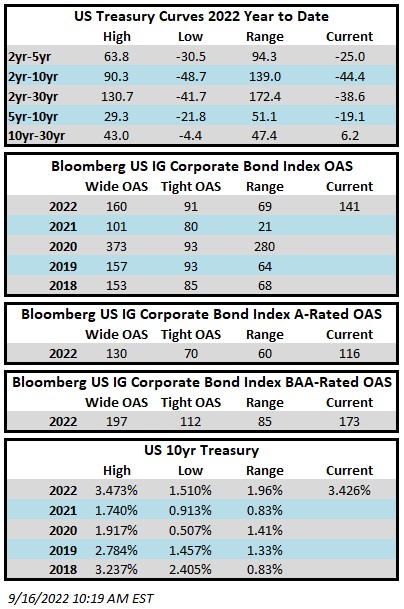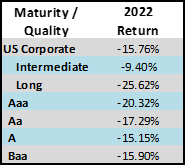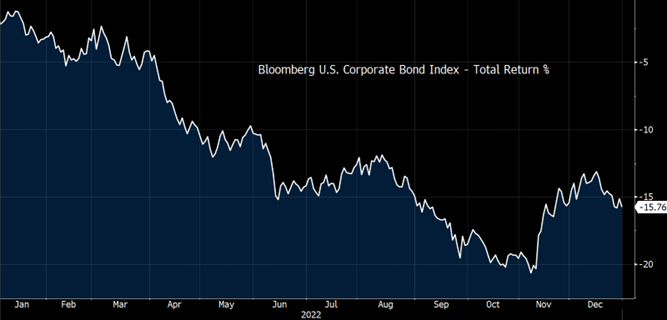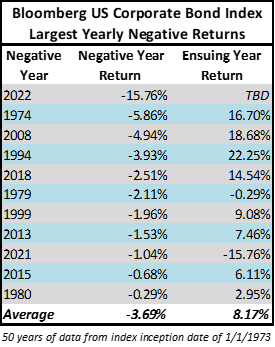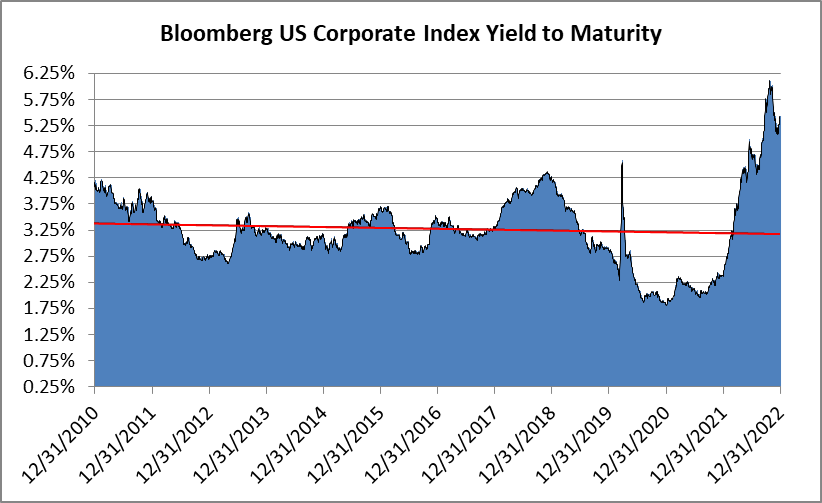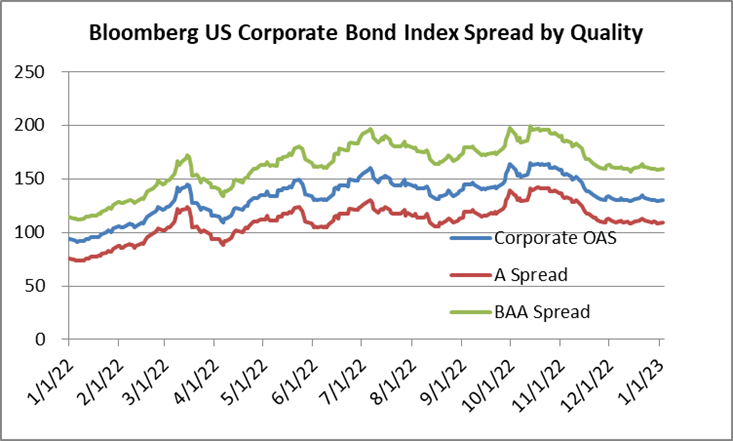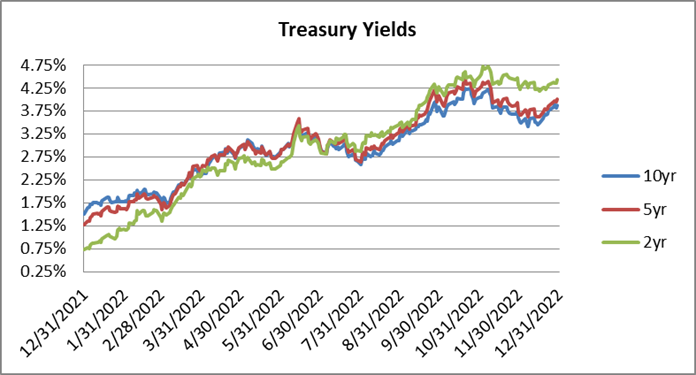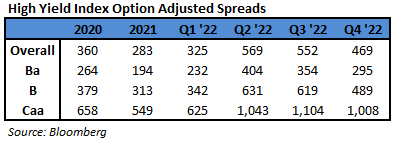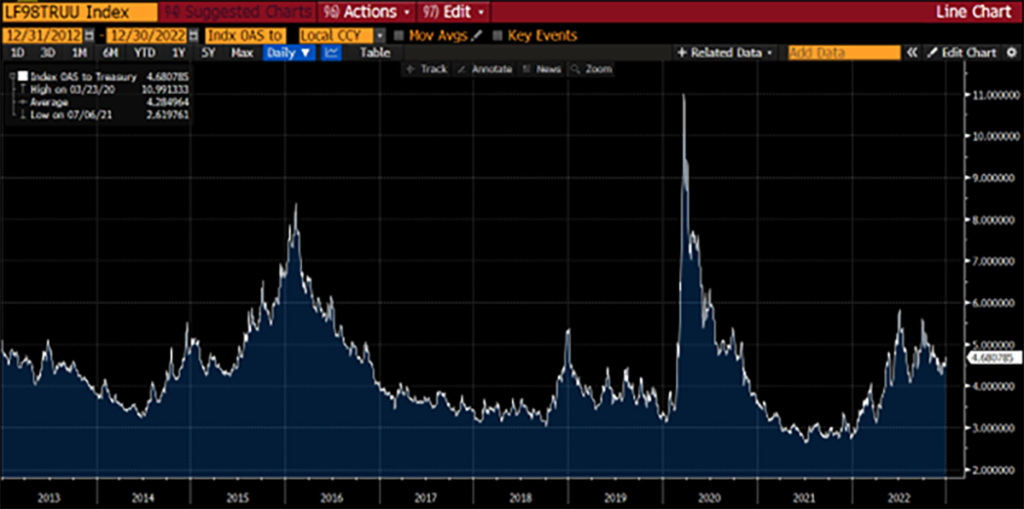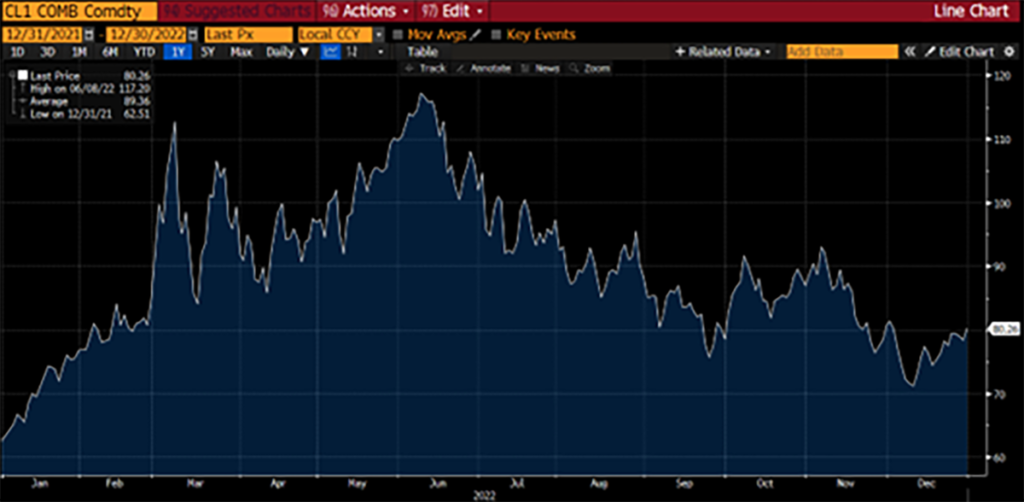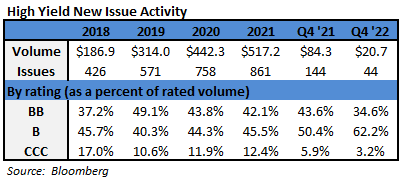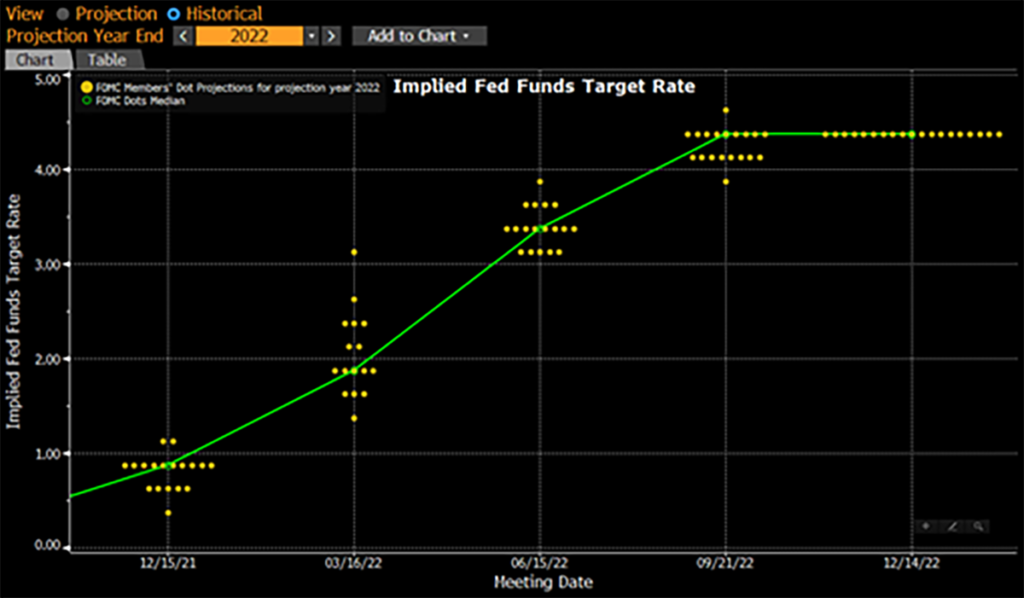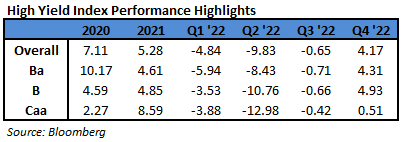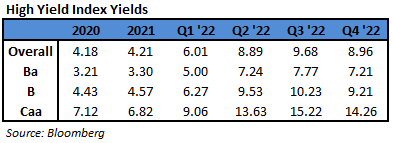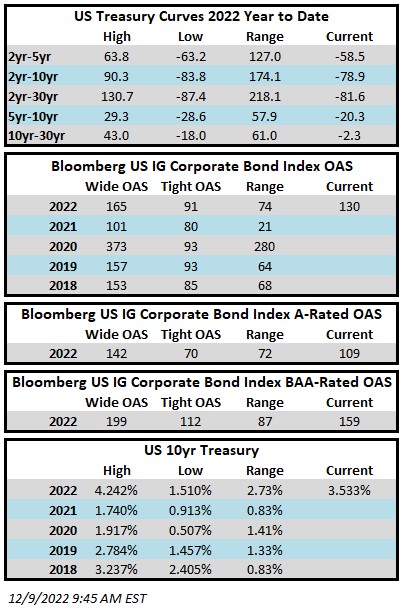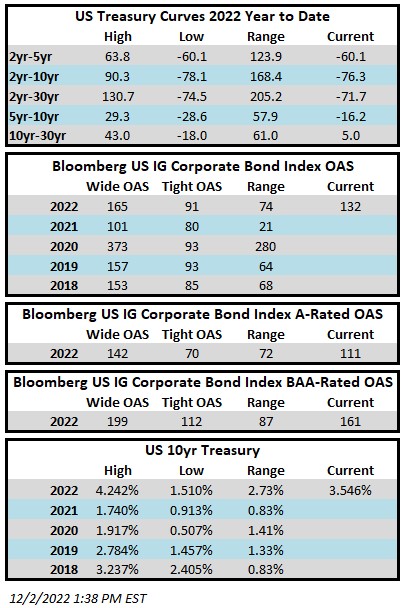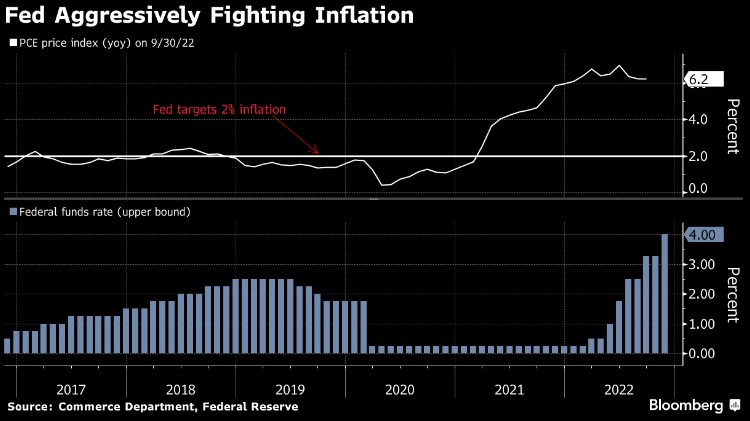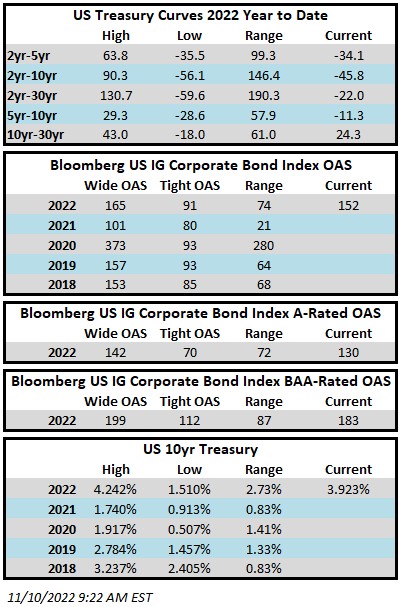Fund Flows & Issuance: According to a Wells Fargo report, flows week to date were $1.8 billion and year to date flows stand at $1.6 billion. New issuance for the week was $1.9 billion and year to date issuance is at $4.7 billion.
(Bloomberg) High Yield Market Highlights
- US junk bonds are poised to post gains for the second consecutive week as yields tumble to a more than four-month low of 8.11% after data showed that US inflation continued to slow, fueling hopes that the Federal Reserve may slow the pace of interest-rate hikes. The gains in junk bonds spanned across ratings as CCCs look to be the best performers for the second week in a row, with week-to-date returns of 2.41%. The rally was also partly driven by cash inflows into junk bond funds.
- US junk bonds are having the best start to a year since 2019. with spreads at a five-month low of +419bps after tightening for eight straight sessions and yields at a more than four-month low.
- CCC yields, the riskiest of junk bonds, dropped below 13% to 12.92%, the lowest since mid-August, after falling for eight sessions in a row, the longest declining streak since September 2020.
- With falling yields and steady gains, the primary market has revived as companies begin looking to borrow again.
- US junk bond gains may pause ahead of bank earnings later today. US equity futures slid as investors assessed prospects for less- aggressive rate hikes and earnings from major banks for insights on the state of the US economy.
(Bloomberg) US Inflation Cools Again, Putting Fed on Track to Downshift
- US inflation continued to slow in December, adding to evidence price pressures have peaked and putting the Federal Reserve on track to again slow the pace of interest-rate hikes.
- The overall consumer price index fell 0.1% from the prior month, with cheaper energy costs fueling the first decline in 2 1/2 years, according to a Labor Department report Thursday. The measure was up 6.5% from a year earlier, the lowest since October 2021.
- Excluding food and energy, the so-called core CPI rose 0.3% last month and was up 5.7% from a year earlier, the slowest pace since December 2021.
- The data, when paired with prior months’ lower-than-expected readings, point to more consistent signs that inflation is easing and may pave the way for the Fed to downshift to a quarter-point hike at their next meeting ending Feb. 1. That said, the central bank’s work is far from over.
- Resilient consumer demand, particularly for services, paired with a tight labor market threaten to keep upward pressure on prices.
- The Fed is expected to raise interest rates further before pausing to assess how the most aggressive tightening cycle in decades is impacting the economy. Policymakers have emphasized the need to hold rates at an elevated level for quite some time and cautioned against underestimating their will to do so. Investors are still betting the central bank will cut rates by year end, despite officials saying otherwise.
- Shortly after the report was released, Philadelphia Fed President Patrick Harker said the central bank should lift interest rates in quarter-point increments “going forward” as it approaches the end point in its hiking campaign.
- Shelter costs — which are the biggest services component and make up about a third of the overall CPI index — increased 0.8% last month, an acceleration from November. Rents and owners’ equivalent rent both rose by the same amount, while hotel stays advanced 1.5% after falling in the prior month.
- Because of the way this category is calculated, there’s a delay between real-time measures — which currently show rents are beginning to decline — and the Labor Department data.
- Given wages make up a large share of these businesses’ costs, economists expect the labor market to play a key role in the inflation outlook. The latest jobs report showed some cooling in earnings growth, but hiring remains robust and the unemployment rate fell to match a five-decade low.
- The persistent imbalance between labor supply and demand remains firmly entrenched, underpinning wage growth and consumer spending at a time when the Fed is trying to slow it down. A separate report Thursday showed inflation-adjusted average hourly earnings rose 0.4% from the prior month, the most in five months. Still, they were down 1.7% from a year earlier.
- While it’s broadly expected for annual price growth to substantially slow this year, a lot of uncertainty remains as to how far inflation may fall and whether the Fed’s rapid rate increases ultimately tip the US into recession.
(Bloomberg) Private Credit Muscles Out Banks, With Worrisome Consequences
- War, inflation and recession fears proved to be devastating for financial markets in 2022. Yet in private credit—one of the most opaque corners of Wall Street, where small groups of institutions and financiers make loans directly to companies—the picture has never looked brighter.
- Private credit has grown quickly, hitting $1.4 trillion of assets under management globally at the end of 2022, up from about $500 million in 2015, putting it on par with the US junk bond market. Research firm Preqin expects private credit to grow to $2.3 trillion by 2027.
- Private credit, like private equity, raises capital from investors, typically large institutions such as pension funds and insurance companies. But instead of taking ownership of a company, as private equity funds do, private creditors lend the money to companies, bypassing banks.
- Because the loans are often used to finance acquisitions by private equity funds, the two industries are intertwined. Many of the largest private equity firms have developed massive private credit operations. The largest, such as Apollo Global Management, Ares Management and Blackstone, have become a force in capital markets, often carrying enough weight to make or break multibillion-dollar acquisitions.
- Yet the inherently risky industry receives little oversight. Most private credit funds and business development corporations, which are companies that hold the assets in a loan portfolio, are only required to make basic quarterly disclosures to the US Securities and Exchange Commission. They aren’t overseen by banking regulators. And most private credit funds haven’t lived through a prolonged recession, which typically brings a spike in defaults.
- Private credit funds are now in direct competition with banks, which have collected hefty fees by acting as intermediaries between companies and investors. That tension was on full display last year, when banks were forced to pare back lending after higher interest rates saddled them with more than $40 billion of debt they were unable to offload, including for the buyout of Twitter Inc. and Citrix Systems Inc. “Historically, private equity firms have felt that the most efficient way to raise capital” has been through banks, where they can get a market price and more transparency, says Andrew McCullagh, managing director and portfolio manager at Hayfin Capital Management in London. “But banks have reduced their appetite to arrange and underwrite, and the direct lending market has naturally moved in to fill that vacuum.
This information is intended solely to report on investment strategies identified by Cincinnati Asset Management. Opinions and estimates offered constitute our judgment and are subject to change without notice, as are statements of financial market trends, which are based on current market conditions. This material is not intended as an offer or solicitation to buy, hold or sell any financial instrument. Fixed income securities may be sensitive to prevailing interest rates. When rates rise the value generally declines. Past performance is not a guarantee of future results.
